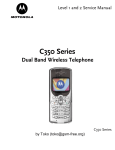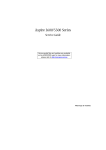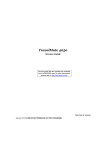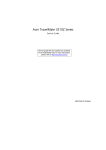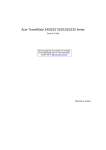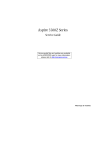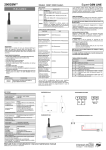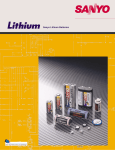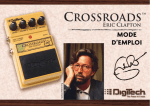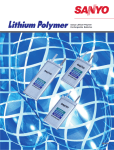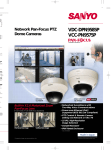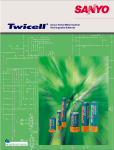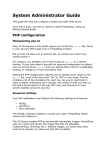Download Sanyo Lithium ion User's Manual
Transcript
Sanyo Lithium ion Rechargeable Batteries URL http://www.sanyo.co.jp/energy/ SEB-016 Lithium-ion Battery Handling Precautions Danger 1 Do not disassemble or modify the battery pack. The battery pack is equipped with built-in safety/protection features. Should these features be disabled, the battery pack can leak acid, overheat, emit smoke, burst and/or ignite. 2 Do not connect the positive (+) and negative (–) terminals with a metal object such as wire. Do not transport or store the battery pack together with metal objects such as necklaces, hair pins, etc. Otherwise, shortcircuiting will occur, overcurrent will flow, causing the battery pack to leak acid, overheat, emit smoke, burst and/or ignite, or the metal object such as wire, necklace or hair pin can generate heat. 3 Do not discard the battery pack into fire or heat it. Otherwise, its insulation can melt down, its gas release vent or safety features will be damaged and/or its electrolyte can ignite, possibly leading to acid leakage, overheating, smoke emission, bursting and/or ignition on it. 15 Do not use the battery pack for a purpose other than those specified. Otherwise, its guaranteed performance will be lost and/or its service life will be shortened. Depending on the equipment in which the battery pack is used, excessively high current can flow through battery pack, possibly damaging it and leading to acid leakage, overheating, smoke emission, bursting and/or ignition. 16 If the battery pack leaks, and the electrolyte gets into the eyes, do not rub them. Instead, rinse the eyes with clean running water and immediately seek medical attention. Otherwise, eye injury may result. Warning 4 Do not use or leave the battery pack near a heat source such as a fire or a heater (80°C or higher). If the resin separator should be damaged owing to overheating, internal short-circuiting may occur to the battery pack, possibly leading to acid leakage, overheating, smoke emission, bursting and/or ignition of the battery pack. 1 Do not use the battery pack in combination with primary battery packs (such as dry-cell battery packs) or battery packs of different capacities or brands. Otherwise, the battery pack can be overdischarged during use or overcharged during recharging, abnormal chemical reactions may occur, possibly leading to acid leakage, overheating, smoke emission, bursting and/or ignition. 5 Do not immerse the battery pack in water or seawater, and do not allow it to get wet. Otherwise, the protective features in it can be damaged, it can be charged with extremely high current and voltage, abnormal chemical reactions may occur in it, possibly leading to acid leakage, overheating, smoke emission, bursting and/or ignition. 2 If recharging operation fails to complete even when a specified recharging time has elapsed, immediately stop further recharging. Otherwise, acid leakage, overheating, smoke emission, bursting and/or ignition can occur. 6 Do not recharge the battery pack near fire or in extremely hot weather. Otherwise, hot temperatures can trigger its built-in protective features, inhibiting recharging, or can damage the built-in protective features, causing it to be charged with an extremely high current and voltage, and, as a result, abnormal chemical reactions can occur in it, possibly leading to acid leakage, overheating, smoke emission, bursting and/or ignition. 7 To recharge the battery pack, use the battery charger specifically designed for the purpose and observe the recharging conditions specified by SANYO. A recharging operation under non-conforming recharging conditions (higher temperature and larger voltage/current than specified, modified battery charger, etc.) can cause the battery pack to be overcharged, or charged with extremely high current, abnormal chemical reaction can occur in it, possibly leading to acid leakage, overheating, smoke emission, bursting and/or ignition. 8 Do not pierce the battery pack with a nail or other sharp objects, strike it with a hammer, or step on it. Otherwise, the battery pack will become damaged and deformed, internal short-circuiting can occur, possibly leading to acid leakage, overheating, smoke emission, bursting and/or ignition. 9 Do not strike or throw the battery pack. The impact might cause leakage, overheating, smoke emission, bursting and/or ignition. Also, if the protective feature in it becomes damaged, it could become charged with an extremely high current and voltage, abnormal chemical reactions can occur, which can lead acid leakage, overheating, smoke emission, bursting and/or ignition. 10 Do not use an apparently damaged or deformed battery pack. Otherwise, acid leakage, overheating, smoke emission, bursting and/or ignition of the battery pack may occur. 11 Do not directly solder the battery pack. Otherwise, heat can melt down its insulation, damage its gas release vent or safety features possibly leading to acid leakage, overheating, smoke emission, bursting and/or ignition. 12 Do not reverse the positive (+) and negative (–) terminals. Otherwise, during recharging, the battery pack will be reverse-charged, abnormal chemical reactions then may occur, or excessively high current can flow during discharging possibly leading to acid leakage, overheating, smoke emission, bursting and/or ignition. 13 The positive (+) and negative (–) terminals are arranged in a particular orientation. Do not force the connection if you cannot easily connect the battery pack terminals to the battery pack charger or other equipment. Confirm that the terminals are correctly oriented. Reversing the terminals will result in reverse-charging, possibly leading to acid leakage, overheating, smoke emission, bursting and/or ignition of the battery pack. 1 14 Do not connect the battery pack to an electrical outlet, vehicle cigarette lighter, etc. When subjected to large voltage, overcurrent can flow on the battery pack, possibly leading to acid leakage, overheating, smoke emission, bursting and/or ignition. 3 Do not put the battery pack into a microwave oven or pressurized container. Rapid heating or disrupted sealing can lead to acid leakage, overheating, smoke emission, bursting and/or ignition. 4 If the battery pack leaks or gives off a bad odor, remove it from any exposed flame. Otherwise, the leaking electrolyte may catch fire, and the battery pack may emit smoke, burst or ignite. 5 If the battery pack gives off an odor, generates heat, becomes discolored or deformed, or in any way appears abnormal during use, recharging or storage, immediately remove it from the equipment or battery pack charger and stop using it. Otherwise, the problematic battery pack can develop acid leakage, overheating, smoke emission, bursting and/or ignition. Caution 1 Do not use or subject the battery pack to intense sunlight or hot temperatures such as in a car in hot weather. Otherwise, acid leakage, overheating and/or smoke emission can occur. Also, its guaranteed performance will be lost and/or its service life will be shortened. 2 The battery pack incorporates built-in safety devices. Do not use it in a location where static electricity (greater than the manufacturer’s guarantee) may be present. Otherwise, the safety devices can be damaged, possibly leading to acid leakage, overheating, smoke emission, bursting and/or ignition. 3 The guaranteed recharging temperature range is 0 to 40°C. A recharging operation outside this temperature range can lead to acid leakage and/or overheating of the battery pack, and may cause damage to it. 4 If acid leaking from the battery pack contacts your skin or clothing, immediately wash it away with running water. Otherwise, skin inflammation can occur. 5 Store the battery pack in a location where children cannot reach it. Also, make sure that a child does not take out the battery pack from the battery pack charger or equipment. 6 Before use, carefully study the Operation Manual and Precautions. For further information, contact a nearest SANYO distributor or representative. Safekeep the manual for future reference. 7 For recharging procedures, refer to the Operation Manual of your battery pack charger. 8 If you find rust, a bad odor, overheating and/or other irregularities when using the battery pack for the first time, return it to your supplier or vendor. Smaller, lighter, more powerful Meeting today’s needs for a compact, portable, and robust source of energy. Devices designed to make our lives easier are being developed at an increasingly rapid pace. With the multimedia age dawning, the market is becoming more diversified with such innovations as lightweight, compact video equipment, personal computers, and data-processing equipments. Such devices have created a need for high-quality, reliable power sources that provide excellent functionality. Sanyo now introduces a series of lithium-ion batteries offering a higher energy density and three times the voltage of Nickel-Cadmium (Ni-Cd) and Nickel-Metal-Hydride (Ni-MH) batteries. What’s more, lithium-ion batteries are composed of materials that are both safer and less damaging to the environment. Smaller, lighter, and more powerful. Sanyo introduces the new generation battery for the forth-coming multimedia age. Higher energy density Higher Voltage Lithium-ion batteries provide a higher energy density per unit volume and unit weight than Built for safety nickel-cadmium and nickel-metal-hydride batteries. With certifications such as UL 1642 In addition, their higher voltage and lighten weight (safety standard for lithium batteries), contribute significantly to the downsizing, Sanyo Lithium-ion batteries ensure of generating an amazing 3.7V per cell — so only one-third the number of batteries is required compared to conventional nickel-cadmium and safety in operation. weight reduction, and simplified operation of Our lithium-ion batteries are capable nickel-metal-hydride batteries. electronic devices. Structure and operation principle Charge Discharge Positive electrode Negative electrode Gravimetric energy density (Wh/kg) Energy density of lithium-ion batteries vs. Ni-Cd and Ni-MH batteries (Sanyo Battery Comparison) *C: Cylindrical P: Prismatic Li-ion Premium(C) Li-ion Premium(P)AI can Li-ion(P)AI can *Cell basis 150 100 Li-ion(C) Li-ion(P) Ni-Cd(C) 50 0 Ni-MH(C) Ni-Cd(P) 0 50 100 150 Ni-MH(P) 200 250 300 Volumetric energy density (Wh/l) 350 400 2 Cylindrical Lithium ion Battery Construction (Cylindrical) PTC device Positive cap Compact and slim Gas release vent Current interrupt device Gasket Features Positive tab Separator Its high energy density makes it possible to smaller design and lighter equipment such as notebook computers which can consume large power. Long operating time Its graphite negative electrode enables the battery pack to operate equipment for a long time with stable discharge voltage. Applications Notebook computer Handy terminal Digital camera Negative electrode Negative tab Casing 3 Insulation Positive electrode Camcorder PDA Other portable equipment Characteristics Charge Characteristics 4.5 Discharge Rate Characteristics Measurement temperature: 20°C Charge: CC-CV:2.1A-4.2V(3hrs.cut) 2500 2500 2000 2000 3.0 1000 2.5 500 current 2.0 0 30 60 90 120 150 180 1500 1000 500 Cell voltage (V) 1500 4.5 Capacity (mAh) capacity 3.5 Current (mA) Cell voltage (V) Cell voltage 4.0 4.0 3.5 3.0 2.5 2.0 0 0 0 400 Discharge Temperature Characteristics 3.5 3.0 2.5 2.0 800 1200 1600 1600 2400 2000 Measurement temperature: 20°C Cycle Conditions:Charge:2.1A-4.2V(CC-CV)[3hrs] Discharge:2.1A(E.V.:2.75V) Residual Capacity (%) Cell voltage (V) 4.0 400 1200 Charge/Discharge Cycle Characteristics 60°C 20°C 0°C –10°C –20°C Charge:CC-CV:2.1A-4.2V(3hrs.cut) Discharge:CC:0.42A(E.V.:2.75V) 0 800 Discharge capacity (mAh) Charge time (min.) 4.5 0.2It(=0.42A) 0.5It(=1.05A) 1.0It(=2.10A) 2.0It(=4.20A) Measurement temperature: 20°C Charge:CC-CV:2.1A-4.2V(3hrs.cut) Discharge:CC:Variable Current(E.V.:2.75V) 2000 2400 100 80 60 40 20 0 0 100 Discharge capacity (mAh) 200 300 Number of cycles Lithium ion Battery Ratings (Cylindrical) Product Number Standard Nominal Voltage Nominal Capacity (mAh) Charge System (V) External Dimensions (mm) Diameter Height Weight (max.g) UR18650F 3.7 2100 18.10 64.80 46.5 UR18500F 3.7 1500 18.10 49.30 35.0 UR18650P 3.7 1700 17.65 64.70 41.5 UR18500P 3.7 1100 17.65 49.20 30.5 UR14650P 3.7 940 13.90 64.70 26.0 UR14500P 3.7 720 13.90 49.20 19.5 1It-4.2V Constant CurrentConstant Voltage (2.5hrs.) Discharge:0.2ItA(E.V.=2.75V) maximum size without tube 4 Prismatic Lithium ion Battery Construction (Prismatic) Negative cap Gasket Gas release vent Sealing plate Insulating spacer Collector Separator Features Compact and slim Smaller space requirement allows designing of smaller and thinner equipment. Light weight Its aluminum alloy casing contributes to a much lighter battery pack, as compared to a stainless steel casing. Applications Cellular phone Digital camera Camcorder Handy terminal Casing 5 Positive electrode Negative electrode PDA Other portable equipment Characteristics Charge Characteristics Discharge Rate Characteristics 1000 800 4.0 capacity 3.5 600 3.0 400 2.5 200 current 2.0 30 0 60 90 120 150 180 0 800 600 400 200 Measurement temperature: 20°C Charge:CC-CV:0.63A-4.2V[3hrs.cut] Discharge:CC:Variable Current(E.V.:2.75V) 4.5 Cell voltage (V) Cell voltage (V) cell voltage Charge current (mA) UF383450P 4.5 Charge capacity (mAh) Measurement temperature: 20°C Charge:CC-CV:0.63A-4.2V[3hrs.cut] UF383450P 4.0 3.5 3.0 2.5 2.0 0 0 100 Discharge Temperature Characteristics 4.0 3.5 3.0 2.5 2.0 200 300 400 400 500 600 700 500 600 Measurement temperature: 20°C Cycle conditions:Charge: 0.63A-4.2V (CC-CV)[3hrs] Discharge: 0.63A(E.V.:2.75V) Residual Capacity (%) Cell voltage (V) UF383450P 100 300 Charge/Discharge Cycle Characteristics 60°C 20°C 0°C –10°C –20°C Charge:CC-CV:0.63A-4.2V[3hrs.cut] Discharge:CC:0.126A(E.V.:2.75V) 0 200 Discharge capacity (mAh) Charge time (min.) 4.5 0.2It(=0.126A) 0.5It(=0.315A) 1.0It(=0.630A) 2.0It(=1.260A) 100 700 UF383450P 80 60 40 20 0 100 0 200 Discharge capacity (mAh) 300 400 500 Number of cycles Lithium ion Battery Ratings (Prismatic) Product Number UF611928P UF553436P UF553040P UF463443P UF611948P UF612248P UF812248P UF102248P UF463048P UF553048P UF653048P UF813048P UF383450P UF463450P UF553450P UF653450R UF103450P UF653467P Nominal Voltage Nominal Capacity Standard (V) (mAh) Charge System 3.7 3.7 3.7 3.7 3.7 3.7 3.7 3.7 3.7 3.7 3.7 3.7 3.7 3.7 3.7 3.7 3.7 3.7 200 680 600 630 420 480 700 900 680 780 830 1000 630 720 860 1000 1700 1200 1It-4.2V Constant CurrentConstant Voltage (2.5hrs.) External Dimensions (mm) Thickness Width Height 6.00 5.40 5.40 4.35 5.80 6.00 7.70 10.30 4.35 5.40 6.30 7.90 3.70 4.30 5.40 6.35 10.50 6.25 19.15 33.85 29.65 33.85 19.15 22.15 22.15 22.15 29.65 29.65 30.15 29.65 33.85 33.85 33.85 33.85 33.80 34.10 27.80 35.80 39.80 42.80 47.80 47.80 47.80 47.80 47.80 47.80 47.80 47.80 49.60 49.80 49.80 49.60 48.80 67.20 Weight (approx. g) 7.0 15.5 14.0 14.8 11.5 12.6 18.0 24.0 14.6 17.3 20.3 25.0 14.4 16.7 21.0 24.0 39.5 31.5 Discharge:0.2ItA(E.V.=2.75V) maximum size without tube. The maximum thickness of the standard shipment charging condition. 6 SANYO Electric Co., Ltd. Soft Energy Company have received the Environmental Management System ISO14001 certification , as a part of the SANYO Electric Group. •Approval Certificate NO:EC00J0303 •Registration Date:19/Mar/2001 USA SANYO Energy (USA) Corporation TEL : (+1) 619-661-6620 FAX : (+1) 619-661-6743 • New Jersey Office TEL : (+1) 201-843-7200 FAX : (+1) 201-843-3870 • Chicago Office TEL : (+1) 630-285-0333 FAX : (+1) 630-285-1133 • Florida Office TEL : (+1) 352-376-6711 FAX : (+1) 352-376-6772 • Atlanta Office TEL : (+1) 770-476-4558 FAX : (+1) 770-476-7558 • Dallas Office TEL : (+1) 972-398-0307 FAX : (+1) 972-398-8477 • CANADA SANYO Canada Inc. TEL : (+1) 905-760-9944 FAX : (+1) 905-760-9303 • EUROPE SANYO Energy (Europe) Corporate GmbH TEL : (+49) 89-4600950 FAX : (+49) 89-460095190 • Scandinavia Representative Office TEL : (+45) 33-27-09-10 FAX : (+45) 33-27-04-44 • Italy Representative Office TEL : (+39) 2-55180490 FAX : (+39) 2-55180502 • France Representative Office TEL : (+33) 1-4131-8484 FAX : (+33) 1-4131-8485 SANYO Energy (UK) Company Ltd. TEL : (+44) 1442-213121 FAX : (+44) 1442-212021 • ASIA SANYO Energy (HK) Company Ltd. TEL : (+852) 2301-2213 FAX : (+852) 2301-2191 SANYO Energy (Taiwan) Company., Ltd. TEL : (+886) 2-8780-8810 FAX : (+886) 2-8780-8850 SANYO Energy (Singapore) Corporation Pte., Ltd. TEL : (+65) 6736-3100 FAX : (+65) 6736-1230 • • • SANYO Electric Co., Ltd. <Soft Energy Company> <Factory. Sales> Sumoto-city, Hyogo, Japan TEL : (+81)799-24-4111 FAX : (+81)799-24-4123 AUSTRALIA SANYO Australia Pty., Ltd. • TEL : (+61) 8825-2822 FAX : (+61) 9678-9381 • more detailed information, contact the above: • For Any and all information on described or contained this bochure are subject to • change without notice due to product / technology improvement, etc. This brochure was printed on recycled paper. Printed in Japan' 2002.10.10,000








